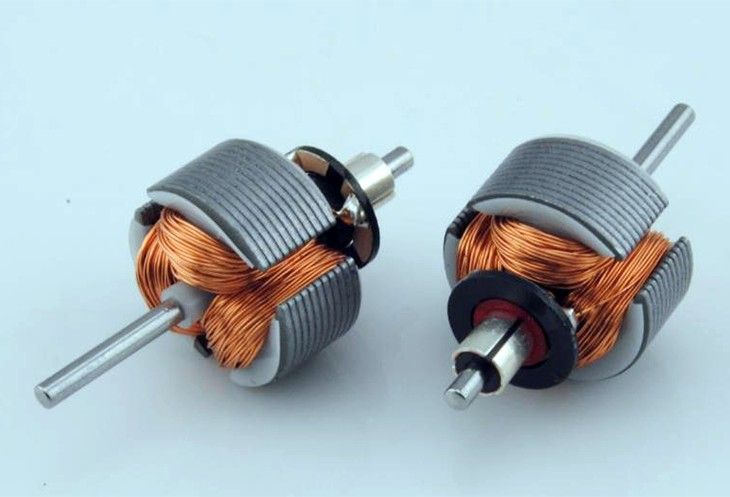Nyob rau hauv kev txhim kho-kev nyab xeeb khoom siv hluav taws xob, xws li tawg-pov thawj motors, transformers, electromagnetic hlau, thiab ballasts rau cov teeb fluorescent, ib feem suav nrog cov windings sab hauv. Cov kev cai rau cov windings no, ob qho tib si mechanically thiab hluav taws xob, yog siab tshaj cov qauv windings.

Feem ntau, insulated hlau siv rau winding cov coils yuav tsum tau muab ob npaug rau-insulated, thiab lub coil qhov ntsuas txoj kab uas hla yuav tsum tsis pub tsawg tshaj 0.25mm.
Rau cov enameled hlau siv nyob rau hauv winding cov coils, Nws raug pom zoo kom siv GB / T6109.2-2008 “Polyester Enameled Round Copper Hlau, Chav Kawm 155,” GB / T 6109.5-2008 “Polyester-imide Enameled Round Copper Hlau, Chav Kawm 180,” GB / T 6109.6-2008 “Polyimide Enameled Round Copper Hlau, Chav Kawm 220,” los yog GB/T6109.20-2008 “Polyamide-imide Composite Polyester lossis Polyester-imide Enameled Round Copper Wire, Chav Kawm 220.”
Ntxiv thiab, Qib 1 enameled round tooj liab hlau raws li teev nyob rau hauv cov qauv no yuav siv tau, yog tias nws dhau qhov kev xeem uas tau teev tseg hauv cov qauv.
Tom qab winding, ib tug tsim nyog impregnating tus neeg sawv cev yuav tsum tau siv los txhim kho lub rwb thaiv tsev zog ntawm windings.
Cov txheej txheem impregnation yuav tsum ua raws li tus neeg tsim khoom tau teev txoj hauv kev, siv cov txheej txheem zoo li dipping, yuam kev, los yog lub tshuab nqus tsev siab impregnation (VPI) txhawm rau sau qhov khoob ntawm cov xov hlau winding thiab xyuas kom muaj zog adhesion. Yog hais tias tus neeg sawv cev impregnating muaj cov kuab tshuaj, lub impregnation thiab ziab yuav tsum tau ua ob zaug kom cov kuab tshuaj evaporation.
Feem ntau, txoj kev xws li tshuaj tsuag los yog txheej rau insulating windings yog suav tias yog unreliable rau Cov khoom siv hluav taws xob tawg. Kev saib xyuas txaus yuav tsum tau muab rau qhov no hauv kev ua haujlwm engineering.
Ntxiv mus, rau high-voltage windings, cov impregnated windings yuav tsum tau kho nrog cov tshuaj tiv thaiv corona los tiv thaiv kev phom sij ntxiv los ntawm corona tawm.
Hauv cov khoom siv hluav taws xob muaj kev nyab xeeb, seb motors, electromagnetic coils, los yog lwm yam khoom siv coils, lawv feem ntau yuav tsum tau nruab nrog kub kev tiv thaiv cov cuab yeej tiv thaiv kom tsis txhob muaj qhov kub siab tshaj qhov kev txwv nyob rau hauv ib txwm ua haujlwm lossis pom qhov txawv txav.
Yog hais tias ib tug winding tsis tshaj qhov txwv kub nyob rau hauv tas li overload (xws li lub cev muaj zog rotor xauv), los yog yog hais tias ib tug winding tsis raug rau overload (zoo li ballast rau cov teeb fluorescent), ces nws tsis tas yuav muaj qhov ntsuas kub tiv thaiv.
Thaum txhim kho-kev nyab xeeb khoom siv hluav taws xob yog nruab nrog cov khoom siv tiv thaiv kub, cov no tuaj yeem ntsia sab hauv lossis sab nraud. Txawm li cas los xij, cov cuab yeej tiv thaiv yuav tsum muaj qhov tsim nyog hom tawg-pov thawj thiab yuav tsum tau soj ntsuam ua ke nrog cov cuab yeej tiv thaiv.
 Shenhai Explosion-Proof
Shenhai Explosion-Proof
